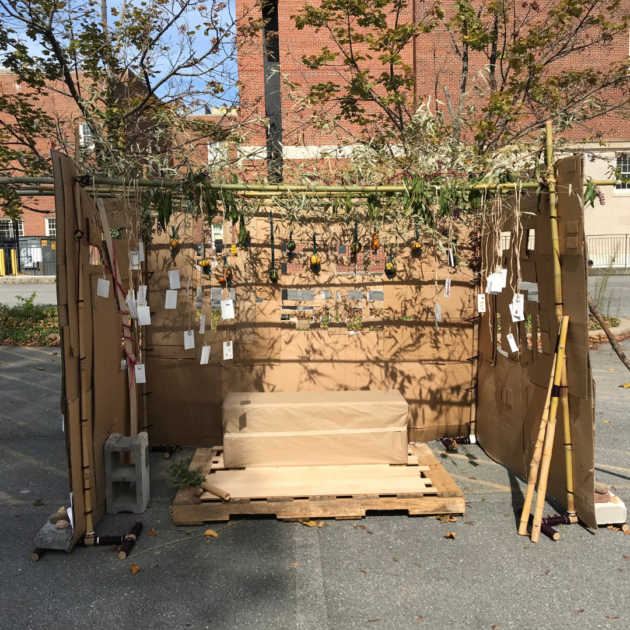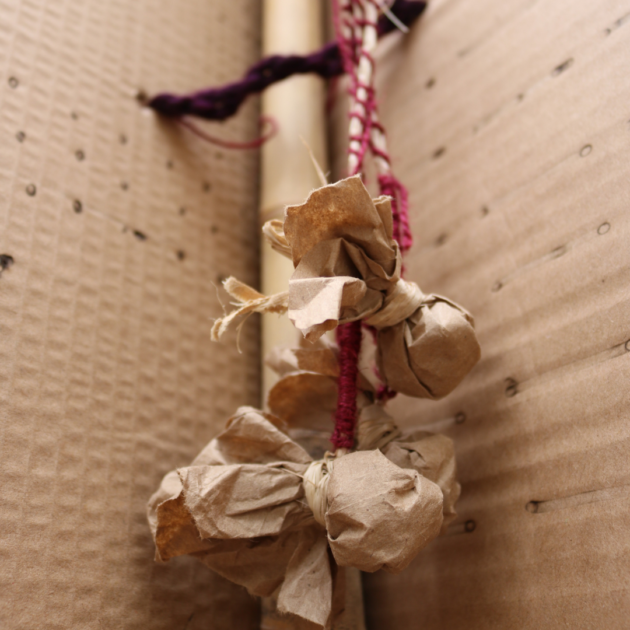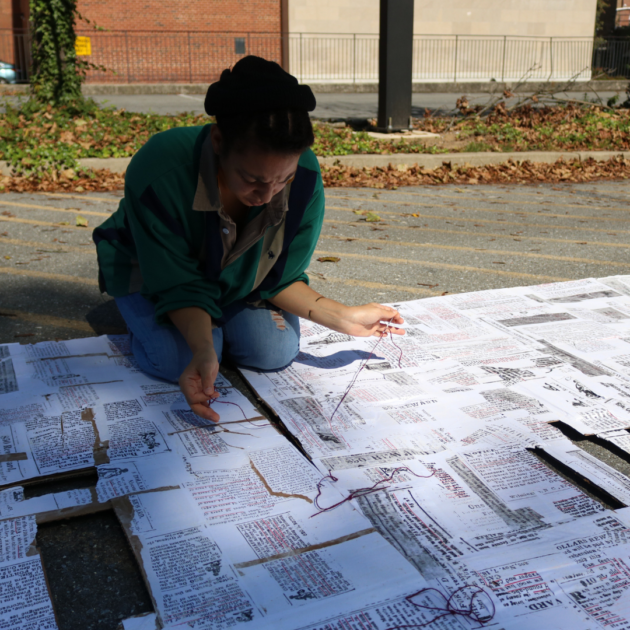The Lilith Blog 1 of 3
October 15, 2020 Chanel Dubofsky
Connecting Jewish Tradition with Black Fugitive Legacies
This autumn, the parking lot of the Halcyon Arts Lab in Washington DC hosted a special sukkah built by visual artist Jessica Valoris. Though its materials—recycled cardboard, paper, bamboo and plant materials—are all things you might expect to find in your average sukkah. this one is anything but; it’s a structure that confronts the past and present, invites us to engage with possibilities of the future. Lilith spoke with Valoris about creating, Black fugitivity, spirituality, and more.





Lilith: On your Instagram account, there are photos of you attaching some news print to the walls of the sukkah. What is that, and what do you want folks to know about it?
Jessica Valoris: There’s a website called Freedom on the Move, which is basically a database of runaway ads, from slavery, posted in newspapers throughout the United States. They’ve been digitally scanned, but they haven’t all been transcribed, so the ask is for people to help transcribe them so they can be an archive. The whole sukkah is basically wheat pasted with these ads.
It’s this archive of Black people who were brave enough to try another way, or to risk everything to be with their family, or to create a life outside the terror of slavery. Each one usually contains the person’s first name, male or female, any identifying characteristics. All the ads are written either by enslavers or by companies who would put out ads on behalf of the enslavers. Police departments would also post them. There’s a lot of language about lurking, and all about the way that Black folks are criminalized, and Black freedom and mobility is criminalized.
Sukkot is a story of fugitivity, and asks the question – what is the making of a people between slavery and liberation? For me, the idea of becoming a people is actually in the space in between, where we’re practicing the kind of world we want to create, but within the confines of the system that we’re dealing with. Our ancestors have something to show us, and so this is a way for me to listen and cultivate listening.

The sizing of the sukkah mirrors underground dugouts that escaped Black people in the US would build in order to set up refuge in the woods, and on the borderlands and outskirts of plantations, where they could be in close proximity to their families. The size of the sukkah is 6ft. x 6ft. x 8ft. I think about how this confined space, neither enslaved, nor fully liberated, was a space for Black people to preserve family and culture as best they could and escape some of the violences of the plantation.
The outside of the sukkah is covered in the runaway ads, in some places it’s the full ad, in others, I ripped them up, but I highlighted the names and details of physical description. I also created pictographs, inspired by each person mentioned in the ads.
It’s a way of thinking about knowledge and memory outside of language, and it creates a kind of a code. I’m adding decorations – pumpkins, gourds, and these small cards with seeds and leaves. There will be a bench inside, and because of COVID, only one person at a time can go inside. A soundscape plays while people experience the sukkah. It combines instrumentionation, music, archival audio recordings of elders, ancestors, and children. There are clips from an interview with Assata Shakur, and poems from Audre Lorde, and songs from the Georgia Sea Island Singers and stories from the elders in my family. It’s intended to inspire people to connect the dots, and honor the legacy of fugitivity that our ancestors created, a legacy that continues on in our movements for justice and liberation, past, present, and future.
Lilith: For people who can’t get to the sukkah, what’s important for you to tell them?
JV: Something that’s important to me right now, especially in the Jewish community, is to reckon with the ways that we have a spiritual tradition that can support liberatory and radical politics, but also how we’re complicit in oppression. For me, the sukkah is this inside/outside space where we can reflect on that. In what ways can we center Black liberation and racial justice? That reflection happens in community and it’s also a soul practice. It’s a marriage of radical politics and spirituality, and how we can use our spirituality and the community that exists around that to create the kind of world we want to see.

In this moment that we’re in, with multiple pandemics, everyone’s asking, what are you doing, how are you going to prepare? I really believe on a spiritual level that we have everything that we need. The preparedness is in the being, and in the ways of being. How do I choose to be with other people? How do I choose to be with myself? What kinds of things can anchor me in those practices? The sukkah is a metaphor for that, I put all this love and intention into creating this space that can be like a sanctuary, but I know that it’s temporary, I know it will fall apart. It’s the way of being that strengthens me. It’s in the process and the practice. The skill is that I can create space no matter what – that’s a legacy of enslaved ancestors. They still found ways to create space for joy, resistance, for leading for themselves and others. That’s the lesson here.

Lilith: What’s your response to the question: How do you make art during times like these?”
JV: Capitalism is a pandemic, anti-Blackness is a pandemic. This isn’t new, although some people are just seeing it. This pandemic has created a space for me to slow down and ask questions – What am I doing? What can I do to honor my legacy? Who am I listening to? My spiritual practice is connected to my ancestors. What do they have to tell us? We have literally been here before, and there’s something in that remembering.
Artists are memory workers – they witness and then create, they bring things back. We have the tools, we can create a way out of nothing. That’s what artists offer right now.
Lilith: What’s next for you creatively?
JV: For the next 4 months, I’m a Halcyon Arts Lab Fellow, which provides me with studio space. In preparation for this opportunity, and because I was feeling called, I spent August in a creative hibernation, studying Black fugitivity. The project I’m working on is called “Black Fugitive Folklore,” and there will be a few iterations of it. I built an incantation bowl. There’s a soundscape, a video. I’m going to keep building things, stay in conversation, and in process. The sukkah is one piece of art in this larger body of work, and is a ritual that will continue to inform my creative practice.
Chanel Dubofsky writes fiction and nonfiction in Brooklyn, NY.
Photographs by Jessica Valoris and Imogen Blue.
 Please wait...
Please wait...